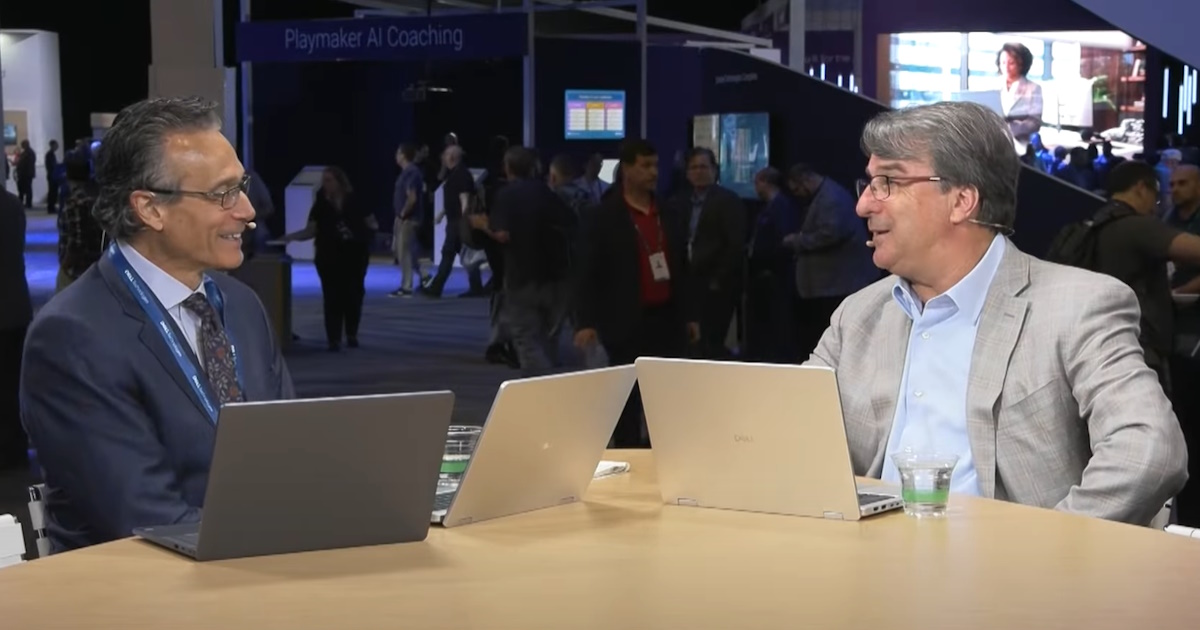Edge computing is emerging as the backbone of next-generation infrastructure, enabling real-time intelligence across diverse industries.
Enterprises are shifting from centralized architectures to distributed systems designed for flexibility, scale and near-instant data processing. At the heart of this transformation is a convergence of trends, hardware acceleration, platform engineering and ecosystem integration, all driving the deployment of intelligent systems at the edge. Industry leaders are now focused on balancing legacy support with the demands of performance-hungry workloads, aiming to deliver operational impact through scalable solutions, according to John Furrier (pictured, right), executive analyst at theCUBE Research.

TheCUBE’s Dave Vellante and John Furrier talk about Dell and edge computing during the day one keynote analysis.
“What I like about Michael Dell and his keynote is that he’s actually singing the same notes,” Furrier said. “I loved the outside of the hokey Dell Street mainstream, which he’s kind of making a good point there, but he opened up on there: He said, ‘Data and AI is running at Mach 3.’ He said 75% of enterprise data will soon be live and processed at the edge. He led with that.”
Furrier spoke with fellow analyst Dave Vellante (left), chief analyst at theCUBE Research, as a part of the day 1 keynote analysis at Dell Technologies World, during an exclusive broadcast on theCUBE, SiliconANGLE Media’s livestreaming studio. They discussed how Dell Technologies Inc. is prioritizing edge computing as a foundational strategy to support real-time data processing, modernize legacy infrastructure and scale intelligent systems across industries. (* Disclosure below.)
Why edge computing is central to Dell’s strategy
Edge computing isn’t just a technical choice; it’s a strategic necessity. Furrier and Vellante talked about how Dell is betting big on decentralized infrastructure, emphasizing that data no longer lives exclusively in core data centers. Instead, insights must be generated closer to where data is created, whether in hospitals, factories or retail environments.
“They got the huge AI factories,” Furrier said. “They want to democratize AI from colossus to the edge, colossus meaning a big, large thing. Not everyone needs that. Not everyone needs to be a hyperscaler is what he’s saying.”
This focus on the edge is closely tied to Dell’s broader ambition to build out artificial intelligence factories that can serve enterprises of all sizes. The term “AI factory” in this context represents more than hardware, it refers to orchestrated platforms that combine storage, networking and compute into a cohesive whole. Dell is also responding to the growing market demand for heterogeneous, mix-and-match architectures that can accommodate Nvidia Corp., Advanced Micro Devices Inc. and other components in an open ecosystem, according to Vellante.
“It’s going to change the world, and it ultimately did change the world,” he said. “It’s a combination of re-architecting your back-office productivity … getting massive value out of data. All of that built together to create what you’ve said will be potentially 100X more than we’ve ever seen. You use that as an example around SaaS, that the new software industry would be 100x what the traditional industry, SaaS industry is. I think that’s how I sum it up.”
Dell faces a dual mandate: Modernize its vast installed base while accelerating adoption of low-latency, edge-enabled infrastructure. With updated GPU racks, thermal innovations and reference architectures, the company is building a hyperscale-ready foundation. But the real challenge lies in timing, Dell must quickly deliver cost-efficient, high-performance edge solutions to stay competitive in a rapidly shifting market.
“Dell has got huge ambitions. They are betting the company and its future on a data-first AI strategy,” Furrier said. “My takeaways, hyperscale to microscale, everything is going microbe at hyperscale. I see a huge surge going into 2026 and beyond for enterprise AI because of microscale and all the things they talk about.”
Here’s the complete video interview, part of SiliconANGLE’s and theCUBE’s coverage of Dell Technologies World:
(* Disclosure: TheCUBE is a paid media partner for Dell Technologies World. Neither Dell Technologies Inc., the primary sponsor of theCUBE’s event coverage, nor other sponsors have editorial control over content on theCUBE or SiliconANGLE.)
Photo: SiliconANGLE
Your vote of support is important to us and it helps us keep the content FREE.
One click below supports our mission to provide free, deep, and relevant content.
Join our community on YouTube
Join the community that includes more than 15,000 #CubeAlumni experts, including Amazon.com CEO Andy Jassy, Dell Technologies founder and CEO Michael Dell, Intel CEO Pat Gelsinger, and many more luminaries and experts.
“TheCUBE is an important partner to the industry. You guys really are a part of our events and we really appreciate you coming and I know people appreciate the content you create as well” – Andy Jassy
THANK YOU
